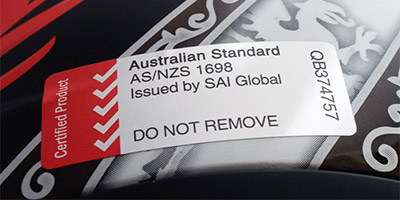Motorcycle helmet laws
South Australia - Motor Bike Helmet Laws
The Australian Road Rules require all motor bike riders and any pillion or sidecar passengers to wear an approved motor bike helmet.
An “approved motor bike helmet” is a helmet made in compliance with —
- AS 1698; or
- AS/NZ 1698; or
- the United Nations Economic Commission for Europe (ECE) standard 22.05;
and has an identifying mark certifying compliance with a standard mentioned above, and that is in good repair and proper working order and condition.
Examples of a helmet that is in good repair and proper working order and condition include a helmet that is scratched or marked but the scratch or mark has not —
- penetrated the helmet's outer shell; or
- damaged the helmet's retention system; or
- damaged the helmet's inner lining.
Full-face helmets offer better face and eye protection than open-face helmets. Around half of all impacts to the head in motorcycle crashes occur to the face.
Full-face helmets also offer better wind and sun protection.
Helmet accessories
All approved helmet standards contain information regarding the attachment of accessories to the helmet.
For AS 1698 and AS/NZS 1698 compliant helmets, as indicated in the standard, no attachments should be made to the helmet except those recommended by the helmet manufacturer.
For ECE 22.05 compliant helmets, no component or device may be fitted to or incorporated in the protective helmet unless it is designed in such a way that it will not cause injury and that, when it is fitted to or incorporated in the protective helmet, the helmet still complies with the requirements of this standard.
Motor bike riders must refer to the instructions for their particular make and model of helmet to determine the suitability for attachments.
Helmet markings
All helmets must be marked to show that they comply with the relevant Australian Standard or ECE 22.05. For helmets that comply with ECE 22.05, the helmet must bear a label displaying an international approval mark. The label may, for example, appear as a sticker on the outside of the helmet or as a label sewn into the retention system of the helmet.
The mark will be in the form of a circle surrounding the letter "E", followed by the distinguishing number of the country that has granted approval. The number to the right of the "E" may vary from one model of helmet to another.
Examples of ECE standard marks are shown below.
 or
or
An example of an Australian standards conformance mark is shown below.

Choosing a helmet
Helmets range in price and construction, so spend time choosing the best protection, the best fit and most comfortable style for you. For more information on helmets, including protection and comfort ratings, visit the Consumer Rating and Safety of Helmets website http://www.crash.org.au/ .
Never buy a second hand helmet. You won't know how it has been treated. It may have damage you can’t see.
Types of helmets
You can choose between:
- full-face or flip-up styles, which have a chin bar to cover the lower face and jaw, or
- open face helmet which leaves your face exposed so there is no protection for the chin and jaw. Many open face helmets offer no eye protection, so you could get hit in the eye by a rock or large bug causing injury or a loss of control; even rain can cause pain and difficulty in seeing clearly.
Helmet fit
Fit your helmet carefully by following these steps:
- with the helmet on, place your hands on the sides of the helmet and move it around - you should feel your skin move with the helmet;
- then move your head from side to side; the helmet should move with you without feeling loose on your head; and
- finally, wear the helmet for a few minutes to make sure it's comfortable.
Gloves, boots, jacket and pants
Don’t forget to wear other protective gear. In the event of a motorcycle crash, in addition to your head hitting something, it's not unusual for hands, elbows, knees and feet to strike the bitumen or other hazards. Wearing protective clothing reduces your risk of serious injury. More information about protective clothing can be found in the Good Gear Guide.
Latest news

National Road Safety Week 2022
15 May 2022National Road Safety Week is being held across Australia from 15 - 22 May 2022.

Travellers through Port Wakefield asked to plan ahead this Easter long weekend
13 Apr 2022Holidaymakers travelling through Port Wakefield over the coming long weekends are being asked to be patient and plan ahead for their journeys, as major project works continue.
News archive
Road safety works

National Road Safety Week 2022
15 May 2022National Road Safety Week is being held across Australia from 15 - 22 May 2022.

Travellers through Port Wakefield asked to plan ahead this Easter long weekend
13 Apr 2022Holidaymakers travelling through Port Wakefield over the coming long weekends are being asked to be patient and plan ahead for their journeys, as major project works continue.
Road safety works archive



